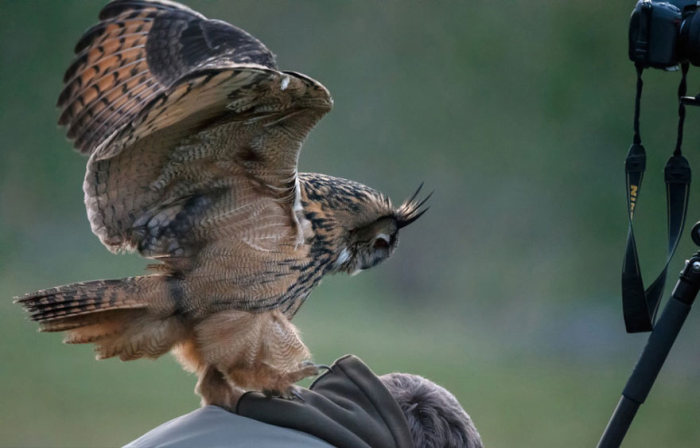|
|
Eurasian Eagle Owl Lands On A Head
|
The Eurasian eagle-owls’ feathers are lightweight and robust but nevertheless need to be replaced periodically as they become worn. In the Eurasian eagle-owl, this happens in stages and the first moult starts the year after hatching with some body feathers and wing coverts being replaced. The next year the three central secondaries on each wing and three middle tail feathers are shed and regrow, and the following year two or three primaries and their coverts are lost. In the final year of this post-juvenile moult, the remaining primaries are moulted and all the juvenile feathers will have been replaced. Another moult takes place during years six to twelve of the bird's life. This happens between June and October after the conclusion of the breeding season and again it is a staged process with six to nine main flight feathers being replaced each year. Such a moulting pattern lasting several years is repeated throughout the bird's life.
Taxonomy
The Eurasian eagle-owl is a member of the genus Bubo, which may include either 22 or 25 extant species. Almost all the larger owl species in the world today are included in Bubo. Based on an extensive fossil record and a central distribution of extant species on that continent, the Bubo appears to have evolved into existence in Africa, although early radiations seem to branch from southern Asia as well. Two genera belonging to the scops owls complex, the giant scops owls (Otus gurneyi) found in Asia and the Ptilopsis or the white-faced scops owl found in Africa, although firmly ensconced in the scops owl group, appear to share some characteristics with the eagle-owls. The Strix is also related to the Bubo and is considered a "sister complex", with the Pulsatrix possibly being intermediate between the two. The Eurasian eagle-owl appears to represent an expansion of the Bubo genus into the Eurasian continent. A few of the other species of Bubo seem to have been derived from the Eurasian eagle-owl, making it a "paraspecies", or they at least share a relatively recent common ancestor. The pharaoh eagle-owl, distributed in the Arabian Peninsula and sections of the Sahara Desert through North Africa where rocky outcrops are found, was until recently considered a subspecies of Eurasian eagle-owl. It appears that the pharaoh eagle-owl differs about 3.8% in mitochondrial DNA from the Eurasian eagle-owl, well past the minimum genetic difference to differentiate species of 1.5%. Smaller and paler than Eurasian eagle-owls, the pharaoh can also be considered a distinct species largely due to its higher pitched and more descending call and the observation that Eurasian eagle-owls formerly found in Morocco (B. b. hispanus) apparently did not breed with the co-existing pharaoh eagle-owls. On the contrary, the race still found together with the pharaoh in the wild (B. b. interpositus) in the central Middle East has been found to interbreed in the wild with the pharaoh eagle-owls, although genetical materials have indicated interpositus may itself be a distinct species from the Eurasian eagle-owl as it differs from nominate subspecies eagle-owls by 2.8% in mitochondrial DNA. The Indian eagle owl was also considered a subspecies of Eurasian eagle-owl until recently, however its smaller size, distinct voice (more clipped and high-pitched than Eurasians) and the fact that it is largely allopatric in distribution (filing out the Indian subcontinent) with Eurasian eagle-owl races has led to it being considered a distinct species. The mitochondrial DNA of the Indian species also appears considerably distinct from the Eurasian species. The cape eagle-owl (B. capensis) appears to represent a return of this genetic line back into the African continent, where it leads a lifestyle similar to northern eagle-owls albeit far to the south. Another offshoot of the northern Bubo group is the snowy owl. It appears to have separated from other Bubo at least 4 million years ago.
|
|









